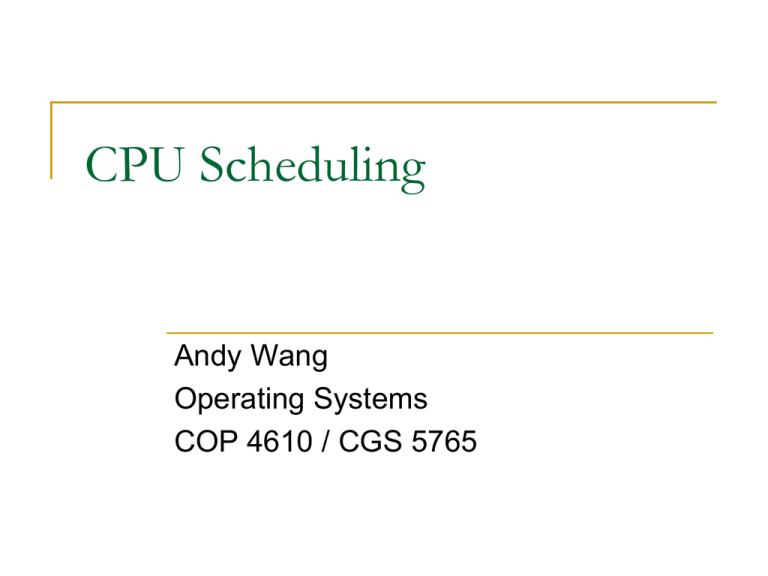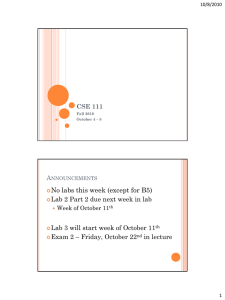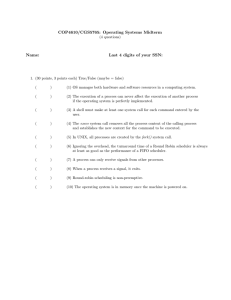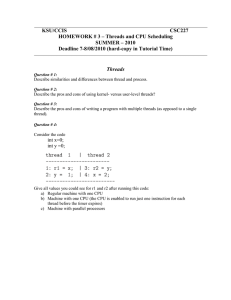CPU Scheduling Andy Wang Operating Systems COP 4610 / CGS 5765
advertisement

CPU Scheduling Andy Wang Operating Systems COP 4610 / CGS 5765 CPU Scheduler A CPU scheduler is responsible for Removal of running process from the CPU Selection of the next running process Based on a particular strategy Goals for a Scheduler Maximize CPU utilization: keep the CPU as busy as possible Throughput: the number of processes completed per unit time Goals for a Scheduler Minimize Response time: the time of submission to the time the first response is produced Wait time: total time spent waiting in the ready queue Turnaround time: the time of submission to the time of completion Goals for a Scheduler Suppose we have processes A, B, and C, submitted at time 0 We want to know the response time, wait time, and turnaround time of process A turnaround time wait time response time = 0 + + A B C A B C A C A C Time Goals for a Scheduler Suppose we have processes A, B, and C, submitted at time 0 We want to know the response time, wait time, and turnaround time of process B turnaround time wait time response time + A B C A B C A C A C Time Goals for a Scheduler Suppose we have processes A, B, and C, submitted at time 0 We want to know the response time, wait time, and turnaround time of process C turnaround time wait time response time + + + A B C A B C A C A C Time Goals for a Scheduler Achieve fairness There are tensions among these goals Assumptions Each user runs one process Each process is single threaded Processes are independent They are not realistic assumptions; they serve to simplify analyses Scheduling Policies FIFO (first in, first out) Round robin SJF (shortest job first) Multilevel feedback queues Lottery scheduling FIFO FIFO: assigns the CPU based on the order of requests Nonpreemptive: A process keeps running on a CPU until it is blocked or terminated Also known as FCFS (first come, first serve) + Simple - Short jobs can get stuck behind long jobs Round Robin Round Robin (RR) periodically releases the CPU from long-running jobs Based on timer interrupts so short jobs can get a fair share of CPU time Preemptive: a process can be forced to leave its running state and replaced by another running process Time slice: interval between timer interrupts More on Round Robin If time slice is too long Scheduling degrades to FIFO If time slice is too short Throughput suffers Context switching cost dominates FIFO vs. Round Robin With zero-cost context switch, is RR always better than FIFO? FIFO vs. Round Robin Suppose we have three jobs of equal length turnaround time of C turnaround time of B turnaround time of A A B C A B C A B C Time Round Robin turnaround time of C turnaround time of B turnaround time of A A B C FIFO Time FIFO vs. Round Robin Round Robin + Shorter response time + Fair sharing of CPU - Not all jobs are preemptive - Not good for jobs of the same length Shortest Job First (SJF) SJF runs whatever job puts the least demand on the CPU, also known as STCF (shortest time to completion first) + Provably optimal + Great for short jobs + Small degradation for long jobs Real life example: supermarket express checkouts SJF Illustrated turnaround time of C turnaround time of B turnaround time of A wait time of C wait time of B wait time of A = 0 response time of C response time of B response time of A = 0 A B C Shortest Job First Time Shortest Remaining Time First (SRTF) SRTF: a preemptive version of SJF If a job arrives with a shorter time to completion, SRTF preempts the CPU for the new job Also known as SRTCF (shortest remaining time to completion first) Generally used as the base case for comparisons SJF and SRTF vs. FIFO and Round Robin If all jobs are the same length, SJF FIFO FIFO is the best you can do If jobs have varying length Short jobs do not get stuck behind long jobs under SRTF A More Complicated Scenario (Arrival Times = 0) Process A (6 units of CPU request) A Time Process B (6 units of CPU request) 100% CPU 0% I/O B 100% CPU 0% I/O Time Process C (infinite loop) 33% CPU 67% I/O C C C C C C Time A More Complicated Scenario FIFO CPU I/O A B C C Poor response and wait time for process C Time Round Robin with time slice = 3 units CPU I/O A B C A C Disk utilization: 29% (2 out of 7 units) B C C Time A More Complicated Scenario Round Robin with time slice = 1 unit CPU I/O A B C A B C A B C A B C A B C A B C C C C C Disk utilization 66% (2 out of 3 units) Time SRTCF CPU I/O C A C C A C C A C C B C Disk utilization: 66% (2 out of 3 units) C B C Time Drawbacks of Shortest Job First - Starvation: constant arrivals of short jobs can keep long ones from running - There is no way to know the completion time of jobs (most of the time) Some solutions Ask the user, who may not know any better If a user cheats, the job is killed Priority Scheduling (Multilevel Queues) Priority scheduling: The process with the highest priority runs first C Priority 0: Priority 1: A Priority 2: B Assume that low numbers represent high priority C A B Priority Scheduling Time Priority Scheduling + Generalization of SJF With SJF, priority = 1/requested_CPU_time - Starvation Multilevel Feedback Queues Multilevel feedback queues use multiple queues with different priorities Round robin at each priority level Run highest priority jobs first Once those finish, run next highest priority, etc Jobs start in the highest priority queue If time slice expires, drop the job by one level If time slice does not expire, push the job up by one level Multilevel Feedback Queues time = 0 Priority 0 (time slice = 1): Priority 1 (time slice = 2): Priority 2 (time slice = 4): A B Time C Multilevel Feedback Queues time = 1 Priority 0 (time slice = 1): Priority 1 (time slice = 2): Priority 2 (time slice = 4): A B C A Time Multilevel Feedback Queues time = 2 Priority 0 (time slice = 1): Priority 1 (time slice = 2): Priority 2 (time slice = 4): A B C A B Time Multilevel Feedback Queues time = 3 Priority 0 (time slice = 1): Priority 1 (time slice = 2): Priority 2 (time slice = 4): A B C A B C Time Multilevel Feedback Queues time = 3 Priority 0 (time slice = 1): Priority 1 (time slice = 2): Priority 2 (time slice = 4): A B C suppose process A is blocked on an I/O A B C Time Multilevel Feedback Queues time = 3 Priority 0 (time slice = 1): Priority 1 (time slice = 2): Priority 2 (time slice = 4): A B C suppose process A is blocked on an I/O A B C Time Multilevel Feedback Queues time = 5 Priority 0 (time slice = 1): Priority 1 (time slice = 2): Priority 2 (time slice = 4): A C suppose process A is returned from an I/O A B C B Time Multilevel Feedback Queues time = 6 Priority 0 (time slice = 1): Priority 1 (time slice = 2): Priority 2 (time slice = 4): A B C B A C Time Multilevel Feedback Queues time = 8 Priority 0 (time slice = 1): Priority 1 (time slice = 2): Priority 2 (time slice = 4): A B C B A C C Time Multilevel Feedback Queues time = 9 Priority 0 (time slice = 1): Priority 1 (time slice = 2): Priority 2 (time slice = 4): A B C B A C C Time Multilevel Feedback Queues Approximates SRTF A CPU-bound job drops like a rock I/O-bound jobs stay near the top Still unfair for long running jobs Counter-measure: Aging Increase the priority of long running jobs if they are not serviced for a period of time Tricky to tune aging Lottery Scheduling Lottery scheduling is an adaptive scheduling approach to address the fairness problem Each process owns some tickets On each time slice, a ticket is randomly picked On average, the allocated CPU time is proportional to the number of tickets given to each job Lottery Scheduling To approximate SJF, short jobs get more tickets To avoid starvation, each job gets at least one ticket Lottery Scheduling Example short jobs: 10 tickets each long jobs: 1 ticket each # short jobs/# long jobs 1/1 0/2 2/0 10/1 1/10 % of CPU for each short job 91% 0% 50% 10% 50% % of CPU for each long job 9% 50% 0% 1% 5%






